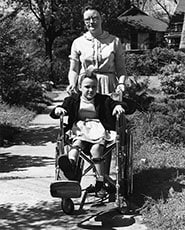![]()

In the late 1940s, polio outbreaks in the U.S. increased in frequency and size, disabling an average of more than 35,000 people each year. Parents were frightened to let their children go outside, especially in the summer when the virus seemed to peak. Travel and commerce between affected cities were sometimes restricted. Public health officials imposed quarantines (used to separate and restrict the movement of well people who may have been exposed to a contagious disease to see if they become ill) on homes and towns where polio cases were diagnosed.
Thanks to the polio vaccine, dedicated health care professionals, and parents who vaccinate their children on schedule, polio has been eliminated in this country for more than 30 years. This means that there is no year-round transmission of poliovirus in the United States.
- Since 1979, no cases of polio have originated in the U.S.
- However, the virus has been brought into the country by travelers with polio. The last time this happened was in 1993.
It takes only one traveler with polio to bring the disease into the United States. People most at risk are:
- Those who never had polio vaccine.
- Those who never received all the recommended vaccine doses.
- Those traveling to areas that could put them at risk for getting polio.
The best way to keep the United States polio-free is to maintain high immunity (protection) against polio in the population through vaccination.
/p>
